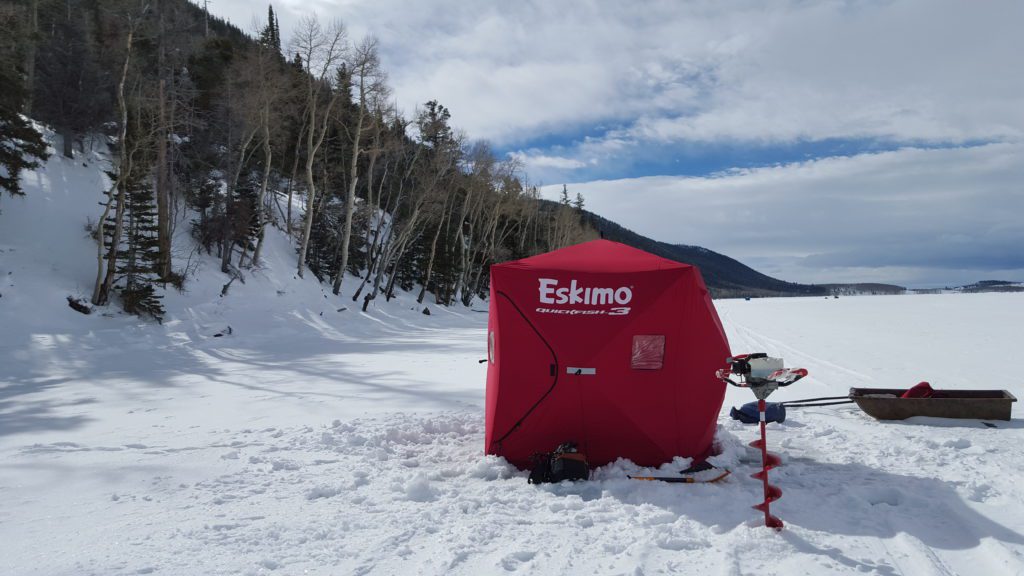Wildlife
Ice Fishing Tips: how to minimize stress on fish before release

Ice fishing in Northeastern Utah. Photo: Courtesy of Utah Division of Wildlife Resources.
UTAH — Ice fishing is a favorite among many anglers across the state as they flock to frozen reservoirs each year. Transporting gear and walking on ice are all part of the fun that culminates in digging a hole in the ice. The freezing conditions are a challenge for any angler, but they are also one for the fish. High-stress levels can mean that even a quick catch and release can still lead to death for the fish.
Surviving the winter for a fish is difficult as the frozen lake restricts wind, sunlight, and other factors from reaching the water and limiting the mixing of the water column. This can lower dissolved oxygen levels in parts of the water body, pushing fish away from certain areas and increasing stress. Because the water the fish is coming out of is above freezing into the air below freezing, there is an additional shock to the fish that only makes them more vulnerable.

“If an angler is fishing on a particularly cold day, pulling a fish up through a hole and exposing them to freezing conditions can be stressful to a fish,” DWR Sportfish Coordinator Randy Oplinger said. “The water that remains on sensitive areas — such as the gills or eyes — can begin to freeze, and this can cause damage to a fish. So, it is best to minimize exposure time and to release the fish as quickly as possible after catching it.”
Similar to handling cold water fish such as trough when temperatures are very hot, the quicker the release, the better chance there is for survival. Having the necessary tools, such as pliers, quickly accessible can mean life or death for the fish.
“A unique aspect of ice fishing is that anglers tend to dress in layers to keep warm, which is definitely recommended,” Oplinger said. “However, they often bury key equipment, such as pliers and cameras, under those layers. Another key aspect of ice fishing is that anglers often fish with two holes that are somewhat separated from each other. This makes it easy to forget key equipment for releasing the fish when you head to another hole in response to a strike. What you don’t want to do is increase air exposure time for the fish because you are scrambling to find equipment. Anglers should carry the equipment needed to release their fish in an easily accessible location.”

Fish species have a protective coating on their skin that makes it harder for parasites to attach and helps ward off diseases. Many warm gloves we wear during the winter have an absorbent fabric, which can remove the protective slime coat and increase the chance of mortality.
“That can leave fish more susceptible to various skin issues, such as fungal diseases,” Oplinger said. “I know it is tough to take gloves off while ice fishing because it’s cold, but handling fish with your bare hands is best. Once the fish have been safely released, then you can put your gloves back on.”

There is an alternative to taking gloves off when going to release a fish. The local Park City Trout Unlimited Chapter, High Country Fly Fishers, has come up with its own Catch and Release Tool that removes the need even to touch the fish. Using the tool also increases the speed at which the fish is returned to the water, increasing the chance of survival. The catch and release tool is free, with the materials listed and instructions on how to build. The chapter has built 500 and has about 100 left that is available to local fly fishers. The chapter is willing to make more if needed. Everything is being done with the thought of being responsible for their environmental impact and protecting the fish they catch.
Visit the Utah State Parks website for tips on how to ice fish safely. Ice-fishing locations can be found on the DWR Fish Utah map along with a rating system for anglers to share their experience and, in turn, help DWR and other anglers know which ice-fishing locations are providing the highest success rate.



















